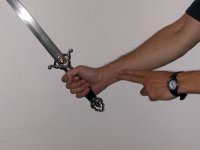 |
I got to do some fencing against some good Western swordfighters, and I got whupped soundly. I learned a lot during the sparring though, including how to see the way my opponent controlled the line with the tip of his sword and how he could hide his range—techniques I use in empty hands fighting, but that I hadn't seen yet in sword fighting. It's one thing to know a technique, but it's another entirely to have that technique used against you just before they stab you in the fencing mask with an aluminum practice sword!
I learned about some shortcomings in the guard I use that night. The grip I use for my sword is similar to a saber grip. It's sturdy, but it gives up range and while it's good for blocking attacks aimed above the waist, it's actually slow against low attacks. Imagine the line the tip of your sword makes going from high to low to block a cut at your knee. That's a long distance, and I tell people I'm teaching fencing that DISTANCE=TIME.
If I adjust my grip so that the blade is flatter, I gain some range and the sword becomes more neutral between high and low attacks, minimizing the time it takes to block high or low. Let the blade fall forward in your palm. Anchor it with your ring finger and loosen your index finger as if you were holding a pistol. Take note! While this grip means less time blocking high or low, if your opponent tends to attack high, the saber grip might actually be better!
